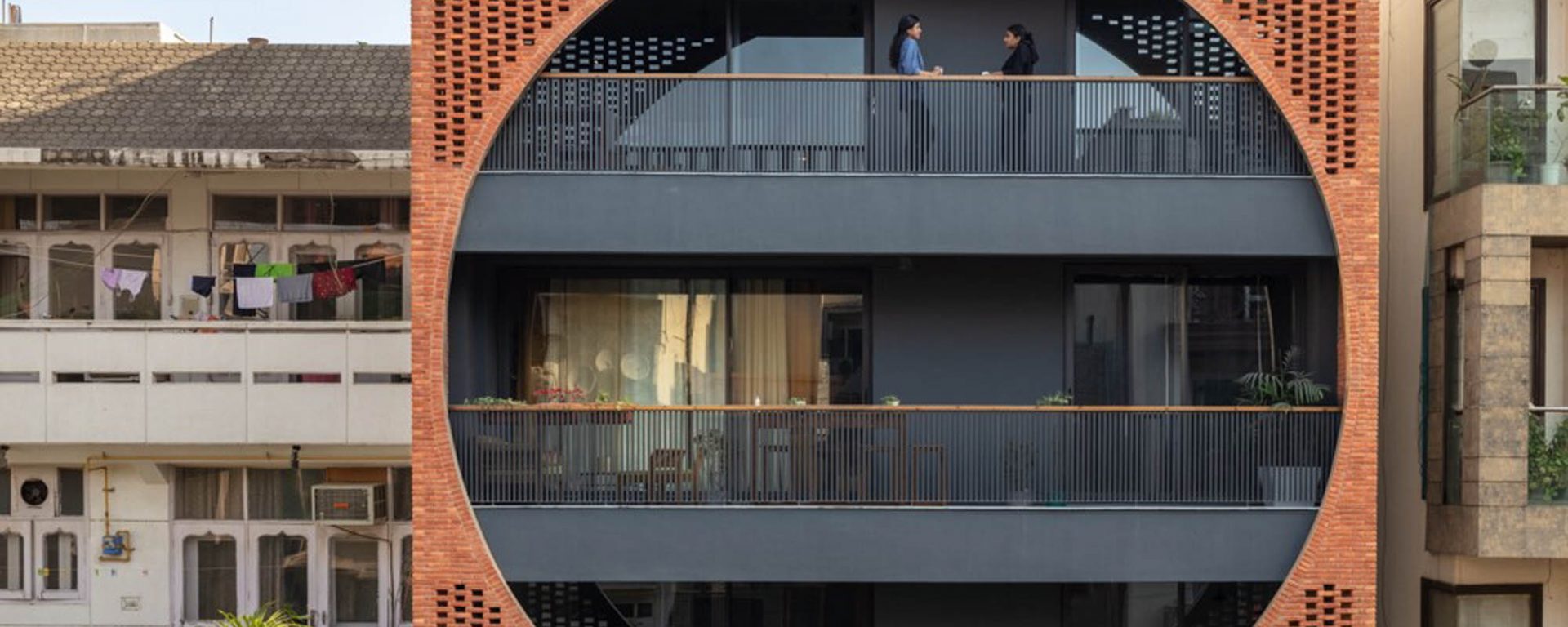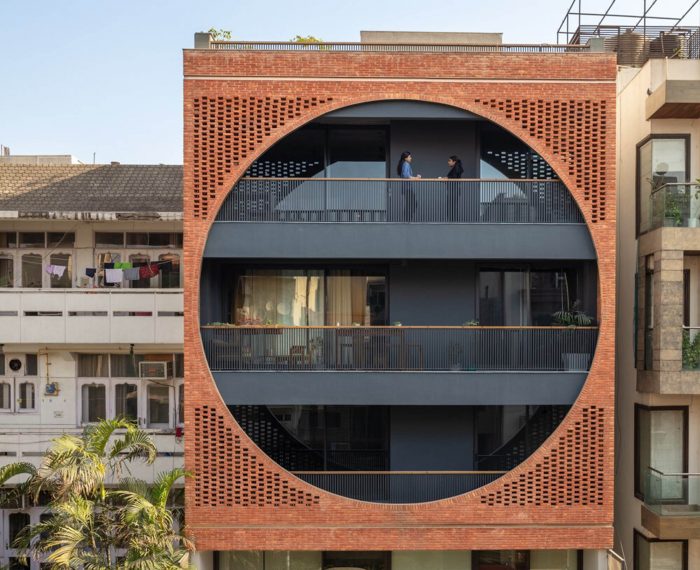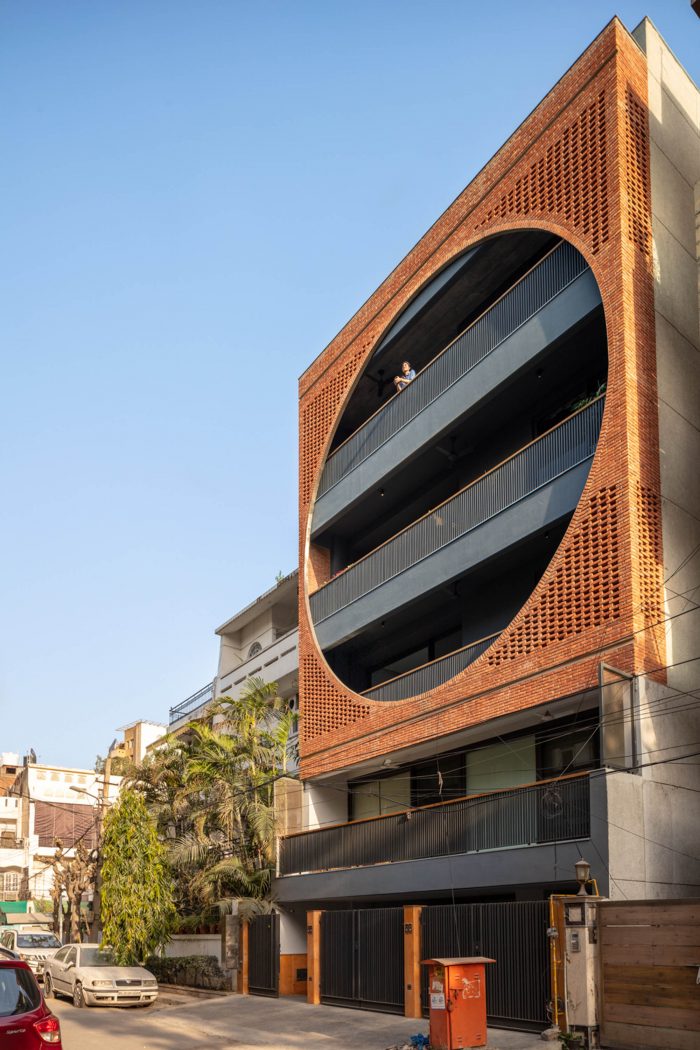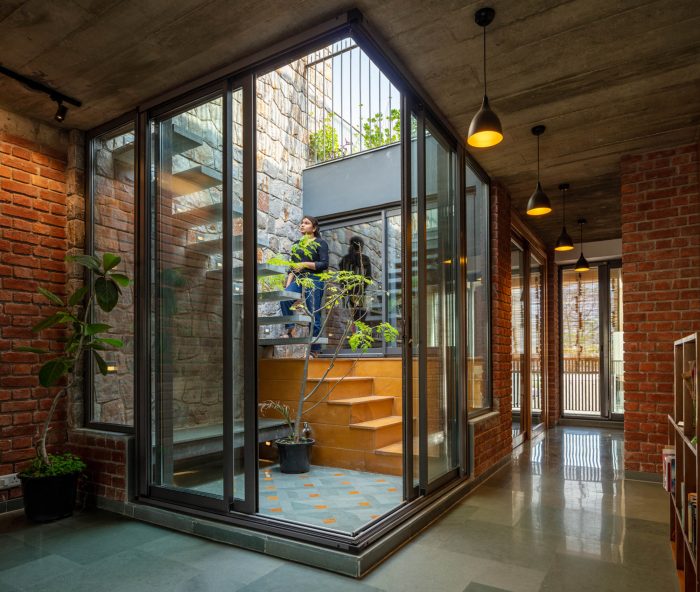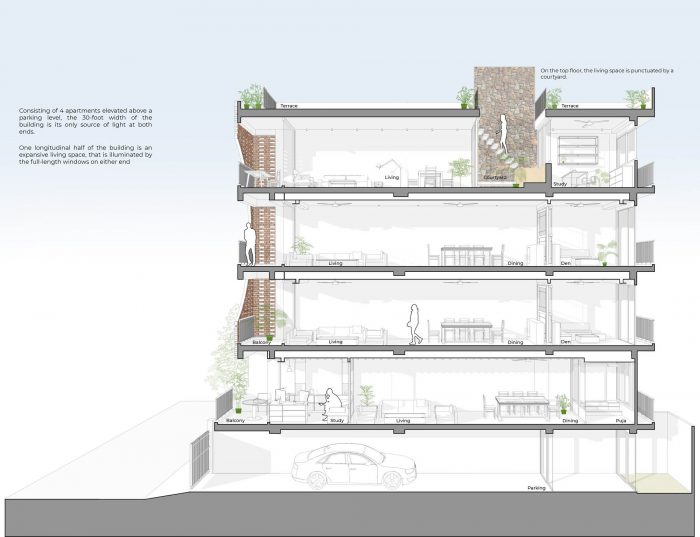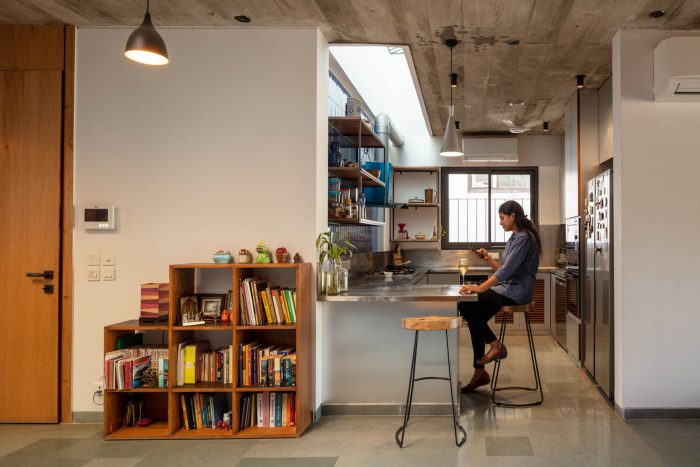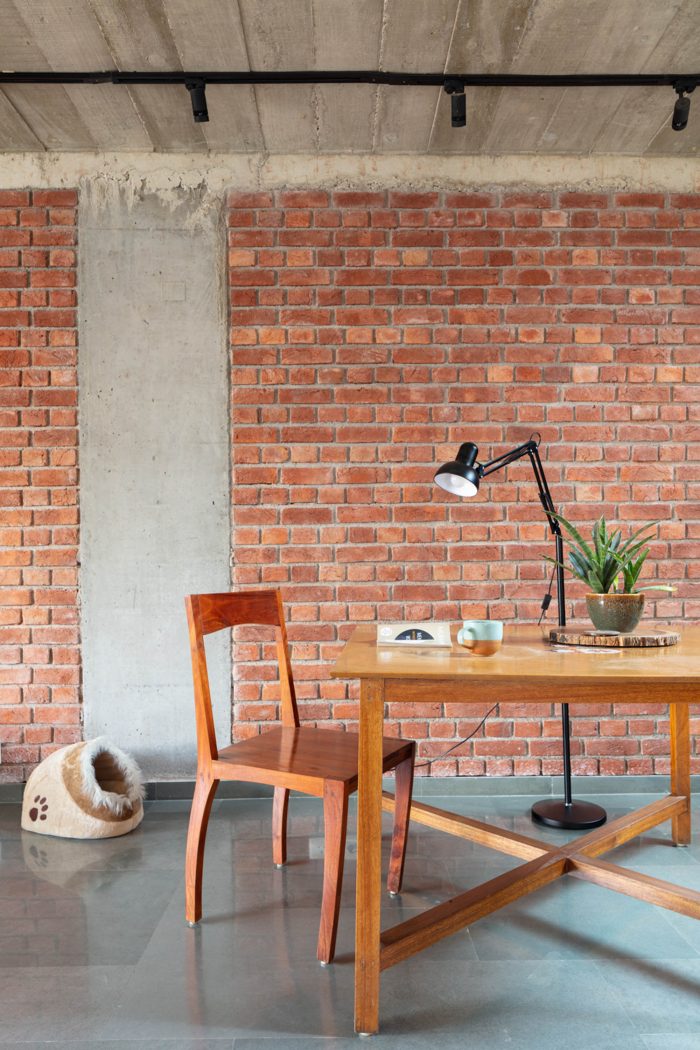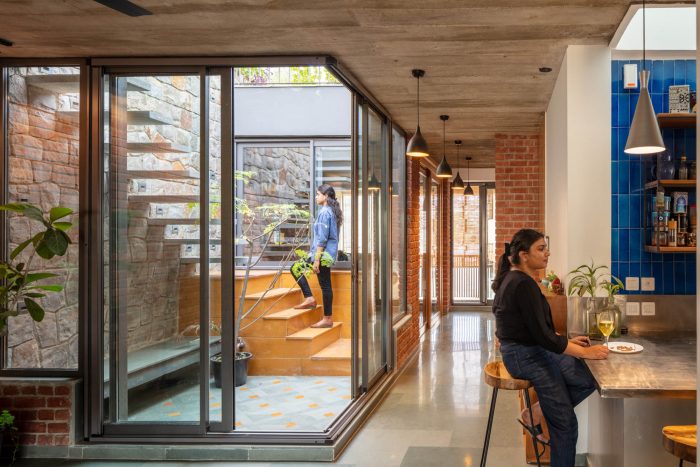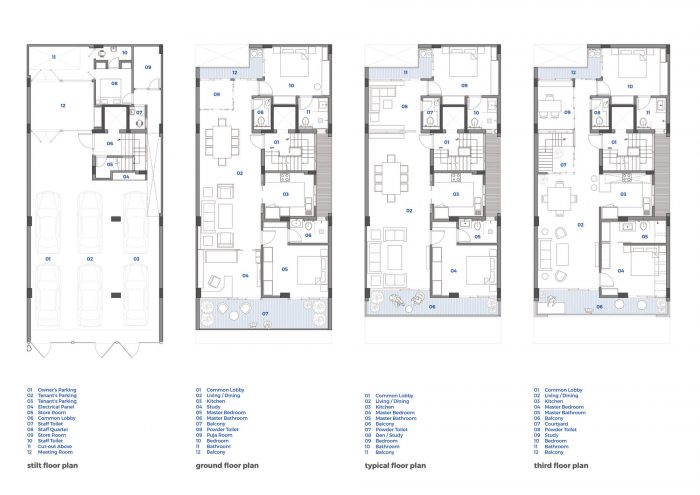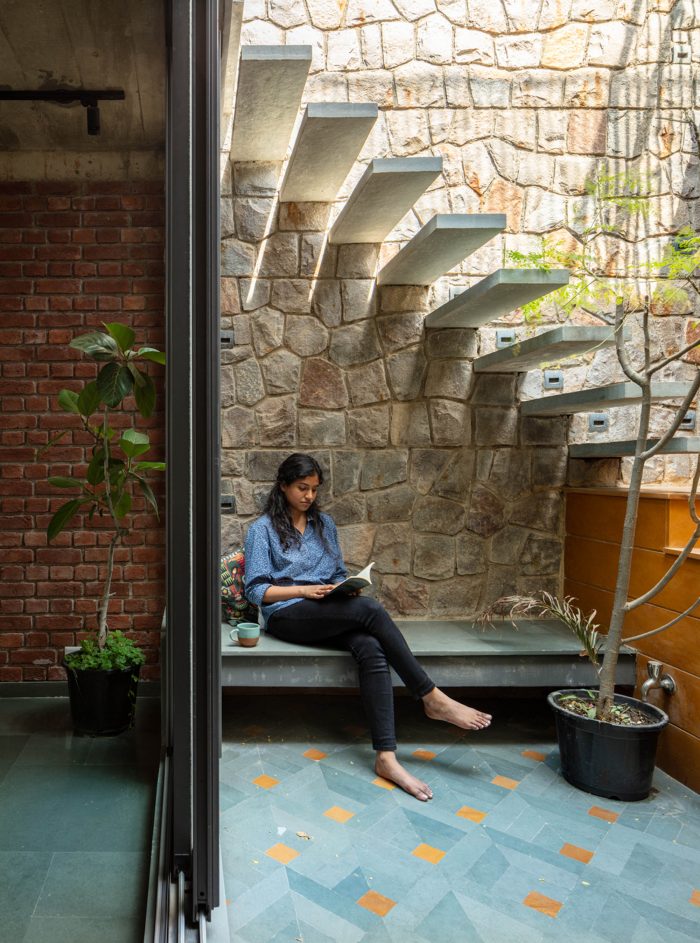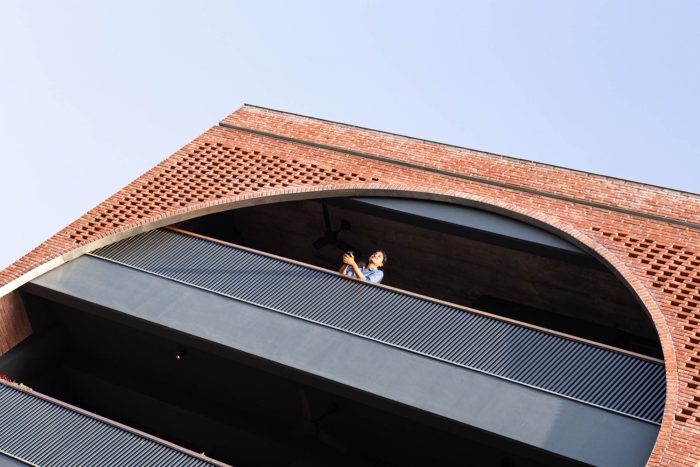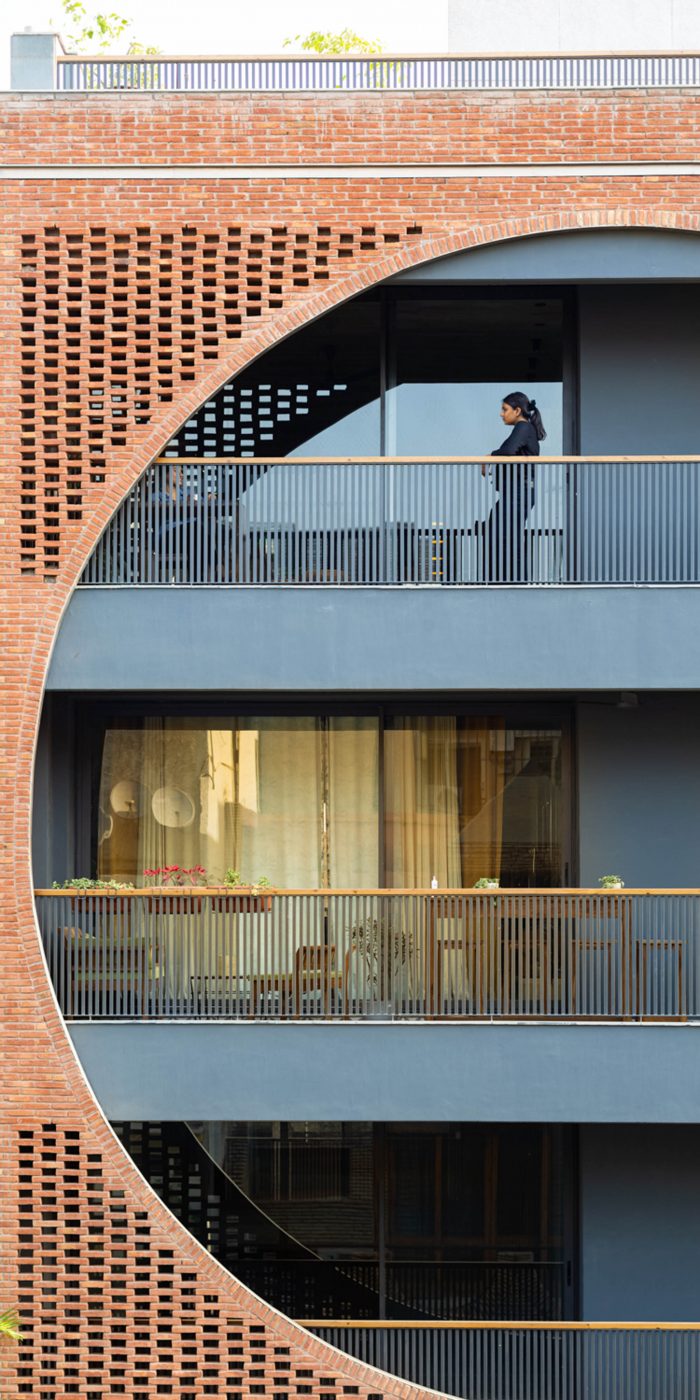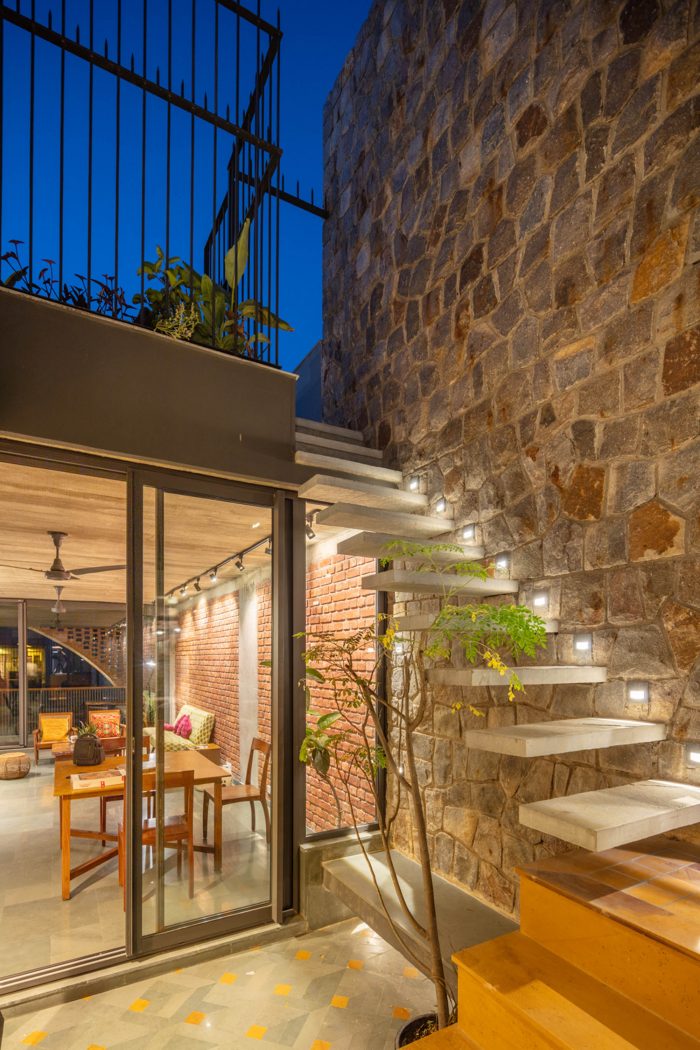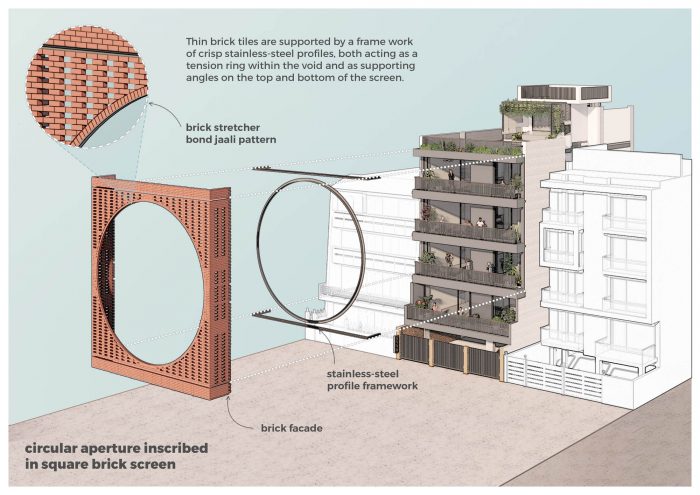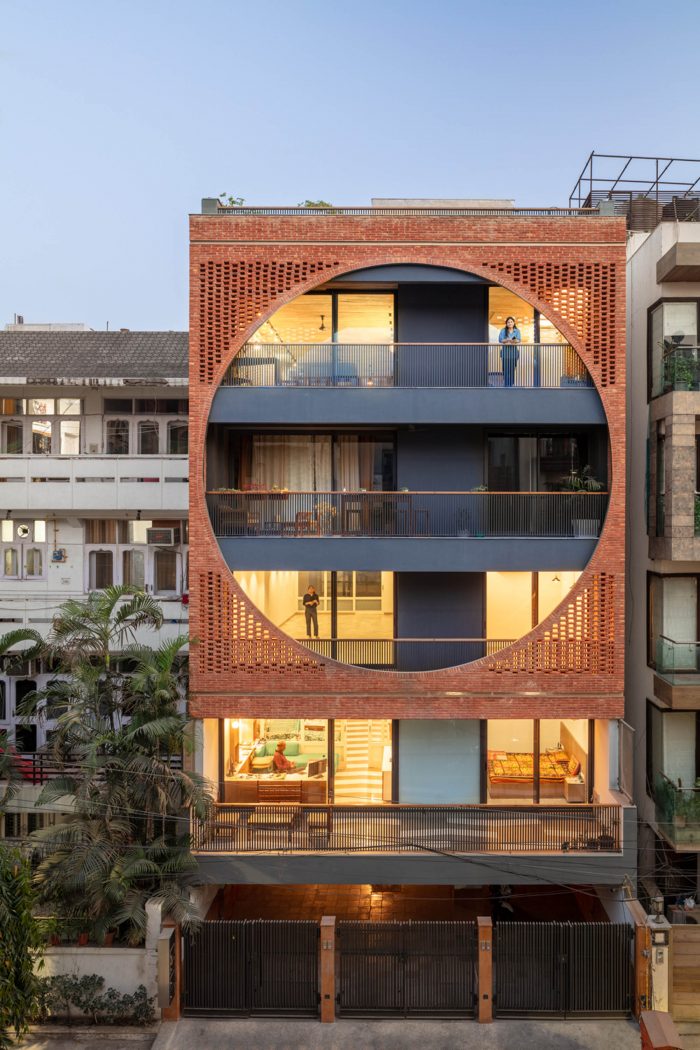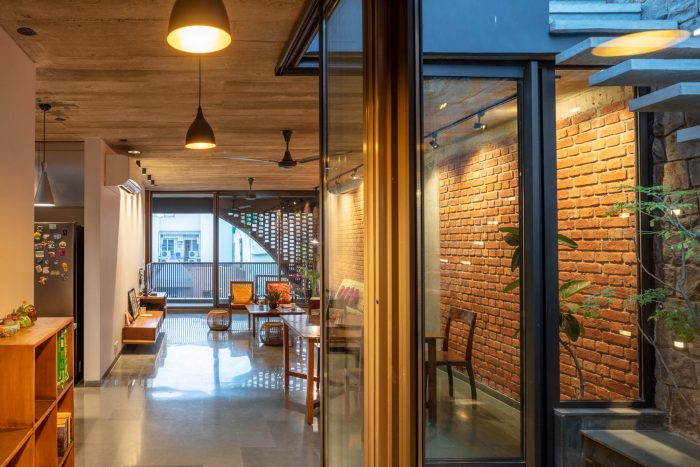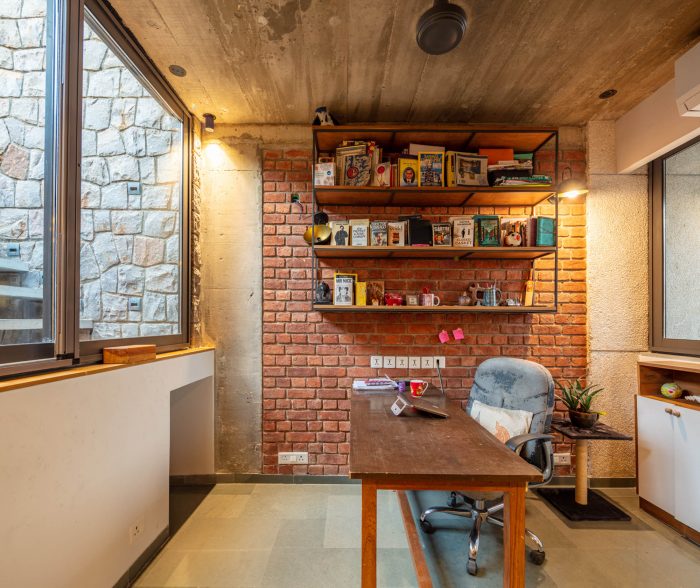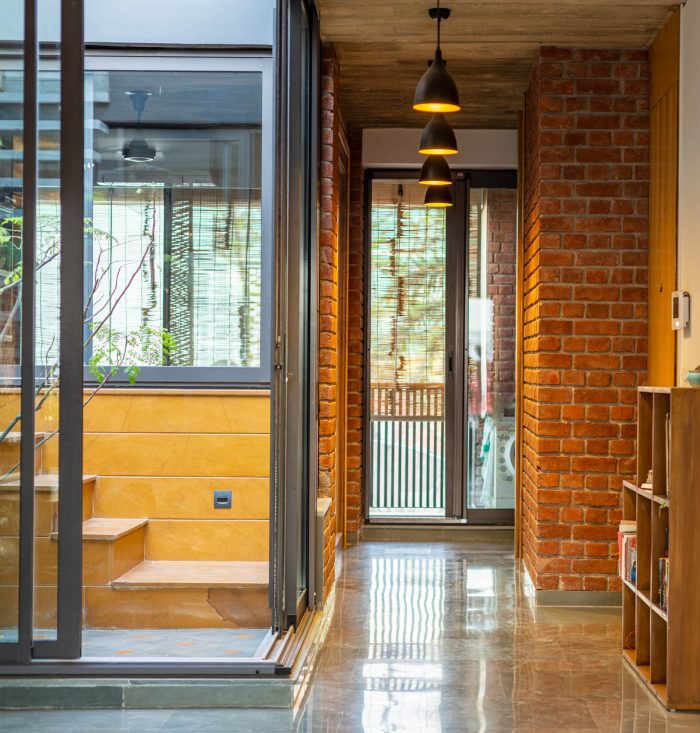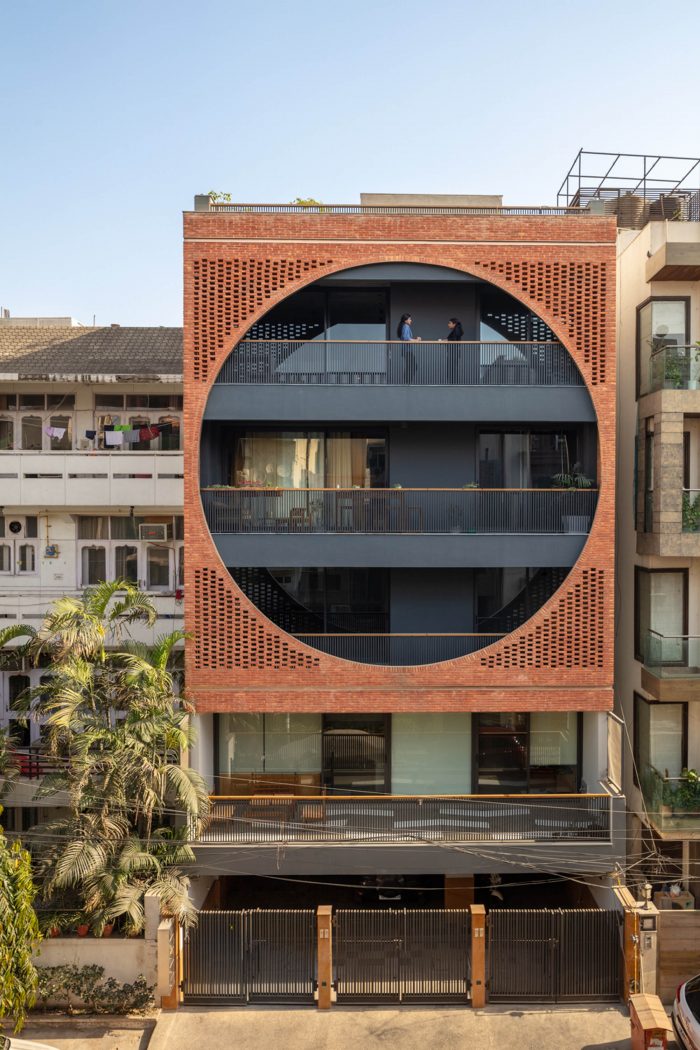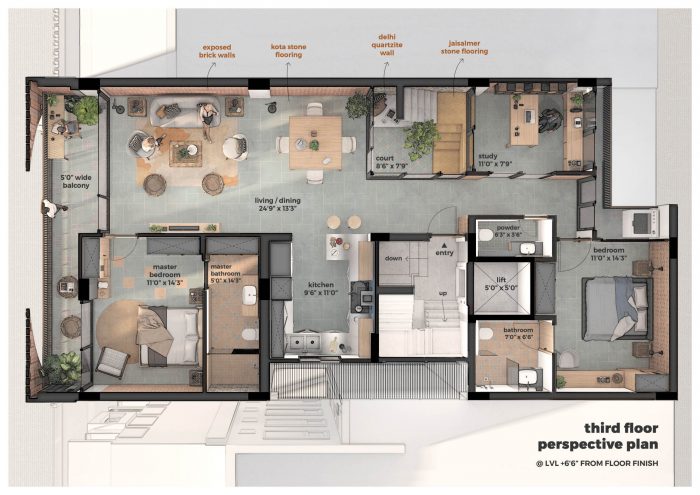在新德里一条安静的住宅街道上,一个不朽的圆形开孔坐落在一个方形的砖块屏幕中。
从本质上讲,这个单一的建筑意图行为定义了这个项目,它是一个由家庭开发的私人使用的公寓建筑。这座建筑的外墙可以被看作是对环境的回应或对物质的反思。然而,它真正代表的是印度现代建筑史上的一次持续对话。这个立面是对一位独特的建筑师所想象的建筑理念的赞美。
On a quiet residential street in New Delhi, a monumental circular aperture sits within a square brick screen.
In essence, this singular act of architectural intent defines the project, which is an apartment building developed by a family for private use. The façade of this building could be seen as a response to the context or a reflection on materiality. However, what it truly represents, is an ongoing conversation in the history of modern architecture in India. This façade is a paean to the idea of architecture as imagined by a singularly extraordinary architect.
路易斯-卡恩的作品给印度次大陆的建筑留下了不可磨灭的印记。他在后殖民时代的框架内工作,一方面是晚期柯布西主义的可塑性,另一方面是区域性的现代主义,他的作品可能相对较少;但它对建筑的实践产生了不成比例的影响。他在艾哈迈达巴德的印度管理学院和达卡的孟加拉国议会中所采用的阴郁的单体形式,与当地材料的强大力量相结合,唤起了一种神秘而又平静的纪念性。
The work of Louis Kahn left an indelible imprint on the architecture of the Indian subcontinent. Working within a post-colonial framework bookended by Late Corbusian plasticity on the one hand and regional modernism on the other, his oeuvre may be relatively diminutive; but it had a disproportionate impact on the practice of architecture. His somber, monolithic forms in the Indian Institute of Management at Ahmedabad and the Bangladesh Assembly at Dhaka, combined with the robust strength of local materials to evoke a mystical, yet calm monumentality.
对他的形式制作来说,关键是用高耸的几何空洞来刺穿看似巨大的砖墙和混凝土墙,在印度刺眼的阳光下形成戏剧性的阴影。这些空隙通常是圆形的;巨大的拱门在其概念化中是纯粹的,在其执行中是完美的,是印度工艺天才的证明。
Crucial to his form-making was the act of puncturing seemingly vast brick and concrete walls with soaring geometric voids, creating dramatic shadows as the harsh Indian sun made its way through the sky. These voids were often circular; vast arches that were pure in their conceptualization and inch perfect in their execution, a testament to the genius of Indian craftsmanship.
因此,这座建筑是对卡恩和他的建筑理念的颂扬。它是千百年来关于建筑的意义通过形式传达的对话的最新篇章。在充斥着世界上所有大城市的城市喧嚣中,创造安静的休息空间是很重要的,这栋建筑所使用的建筑语言努力重新创造出这种急需的平静感。
This building, therefore, is an ode to Kahn and his idea of how a building should be. It is the latest chapter in a millennia long conversation about the meaning of architecture as conveyed through form. Within the urban cacophony that permeates all large cities of the world, it is important to create spaces for quiet repose and the architectural language used in this building strives to recreate that much needed sense of calm.
该项目由4套公寓组成,位于停车层之上,两边都有邻居在围观。建筑物的30英尺宽度是其两端的唯一光源。公寓的平面图是还原性的,所有的服务都集中在建筑一侧的核心部分,包括楼梯、电梯、3个浴室、厨房和两个卧室。建筑的另一半纵向是一个广阔的生活空间,它被两端的全长窗户所照亮。在顶层,这个开放的空间被一个向外界开放的院子所点缀。
Consisting of 4 apartments elevated above a parking level, the property is hemmed in by neighbors on both sides. The 30-foot width of the building is its only source of light at both ends. The floor plans of the apartments are reductive, with all services concentrated in a core on one side of the building, including the staircase, elevator, 3 bathrooms, the kitchen and both bedrooms. The other longitudinal half of the building is an expansive living space, that is illuminated by the full-length windows on either end. On the top floor, this open space is punctuated by a courtyard that is open to the elements.
在立面上,薄薄的砖瓦被一个清脆的不锈钢型材框架所支撑,既作为空隙内的张力环,又作为屏幕顶部和底部的支撑角。整个砖砌屏风被抬离地面,其比例是一个完美的正方形,环绕着一个圆。裸露的侧墙和后墙在白色水泥抹灰中用裸露的砂砾进行装饰。
On the façade, thin brick tiles are supported by a framework of crisp stainless-steel profiles, both acting as a tension ring within the void and as supporting angles on the top and bottom of the screen. The entire brick screen is elevated off the ground level, proportioned to be a perfect square circumscribing a circle. The exposed side and rear walls are finished in an exposed grit wash set in white cement plaster.
在室内,裸露的砖墙与板状的混凝土形成了鲜明的对比。室内的地板采用了当地的科塔铺路板,在院子和浴室里洒上了芥末黄的杰萨尔梅尔石。开放式厨房中的不锈钢柜台被后挡板上的蓝色手工瓷砖所抵消。开放式厨房本身位于开放式庭院的对面,2英寸厚的科塔石台阶从石英石墙上悬垂下来,一直延伸到天空。
Within the interior, exposed brick walls contrast with the board-formed concrete of the slab. locally sourced Kota paving slabs are used for the flooring of the interior, sprinkled with mustard yellow Jaisalmer stone in the courtyard and the bathrooms. A stainless-steel counter in the open kitchen is offset by blue handmade tiles in the backsplash. The open kitchen itself sits opposite the open courtyard, animated by 2” thick Kota stone steps cantilevered from a quartzite wall that rises to the sky.
该项目说明了人们对材料在我们恶劣气候下的耐久性的理解在不断发展。砖是固有的耐用材料–粘土砖几乎可以无限期地使用,在很大程度上不受火灾、风载碎片和温度波动的影响,其特殊的热质量有助于缓解热传导。在总拥有成本和生命周期的基础上,砖的性能几乎超过了其他所有的建筑材料,有效地减少了其他系统如空调和暖气对环境的影响。
The project illustrates an evolving understanding about the durability of materials in our harsh climate. Brick is inherently durable – Clay bricks last almost indefinitely, being largely immune to fire, wind borne debris, and temperature fluctuations and their exceptional thermal mass helps mitigate heat transfer. On a TCO and lifecycle basis, bricks outperform almost every other building material, effectively reducing the environmental impact from other systems like air conditioning and heating.
该建筑的每一个部件都是按照高性能、固有的坚固性和能源效率的参数来选择的。周围都使用了双层玻璃的铝窗,露台用倒置的花盆覆盖赤土砖进行保温,空调在主动监测室内使用情况的基础上使用可变制冷剂量,整个建筑使用LED照明。洗手间里安装了传感器,它们根据运动和环境光线条件自动控制灯光。公寓有一个无钥匙的中央安全系统,有数字门禁。
Every component of the building has been selected with the same parameters of high performance, inherent robustness and energy efficiency. Aluminum windows with double glazing are used all around, the terrace is insulated with inverted pots overlaid with terracotta tiles, the air-conditioning uses variable refrigerant volume based on active monitoring of indoor use, and LED lighting is used throughout the building. Sensors are fitted in the washrooms, and they automatically control the lights based on movement and ambient light conditions. The apartments are secured with a keyless central security system with digital access.
印度后独立时代的建筑质量一直是一个争论的焦点,因为现代主义的设计理想偏好迫使人们放弃传统工艺,追求平淡的简单。这个项目试图结束这些理想,放弃现代性以追求可持续性、意义和工艺。
The quality of buildings in the post-independent era of India has always been a source of debate, as modernist predilections of design ideals forced the abandonment of traditional craftsmanship in the pursuit of bland simplicity. This project seeks to up-end those ideals, fore-going modernity in the pursuit of sustainability, meaning and craftsmanship.
Architects: AKDA
Area: 800 m²
Year: 2021
Photographs: Andre Fanthome
Manufacturers: Atlas Schindler, Jaquar, Kronotex, Kota Stone, Mitsubishi, Schueco
Contractor: Build Design Workshop
Design Team:Amit Khanna, Ankita Misra, Krishna Yadav
Architect:AKDA
City:New Delhi
Country:India

